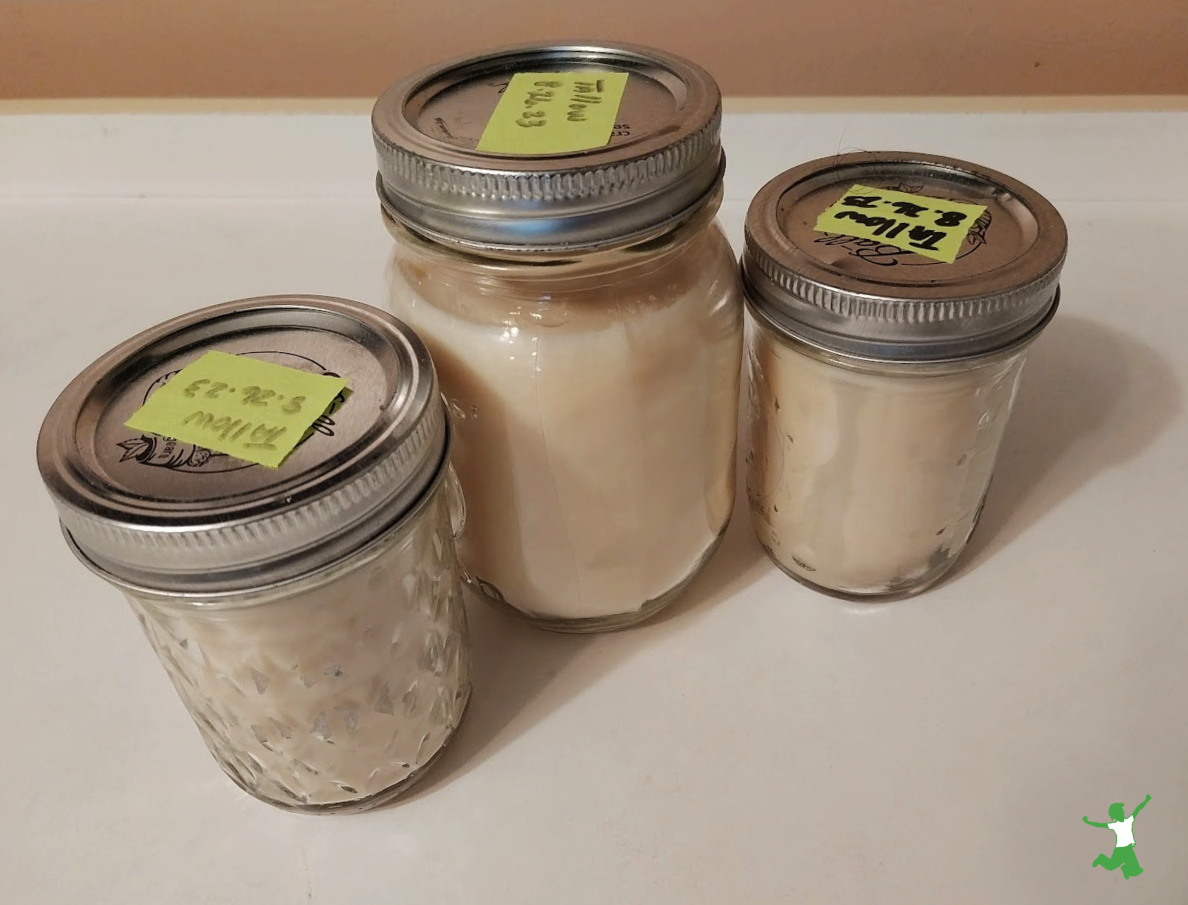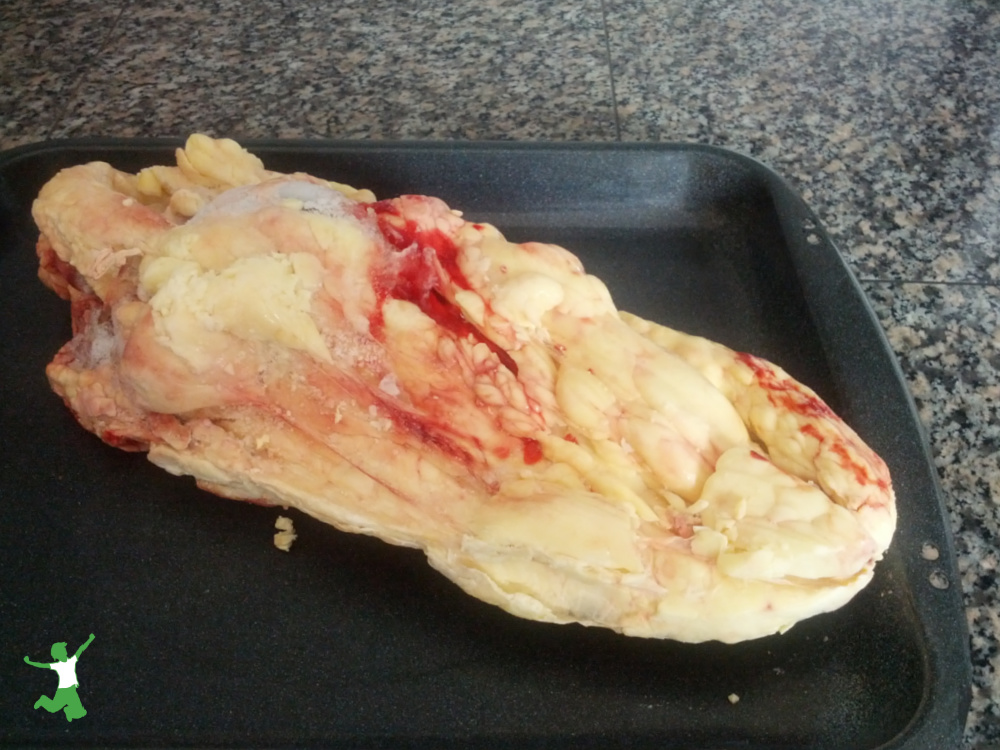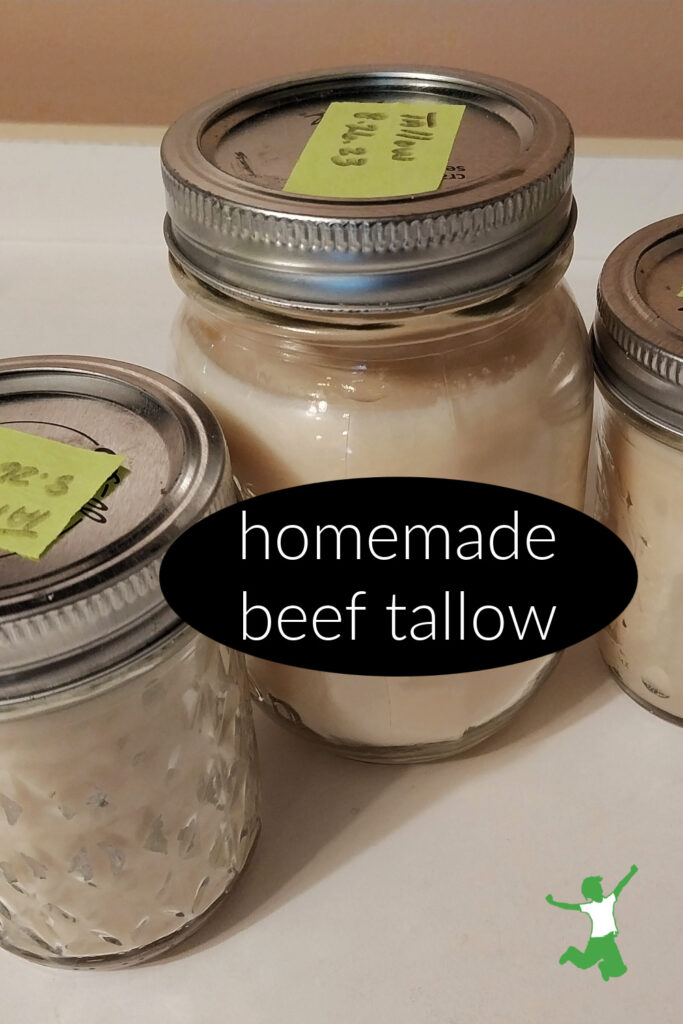How to render tallow from an intact piece of beef suet from your grassfed farmer. This traditional recipe with video how-to makes several jars of tasty pastured beef tallow to last you many months or even a year!

Tallow is hands down my favorite traditional fat to use for frying. I like it even more than lard. It is ideal for this purpose as it has less than 3% polyunsaturated fats. This amount is just a bit less than coconut oil.
What’s more, if your tallow comes from cattle finished on grass or given grain for a very short period of time (a few weeks at the most) before processing, a good share of those polyunsaturates are in the form of conjugated linoleic acid (CLA).
This fatty acid helps build muscle, assists with weight loss, and drastically reduces cancerous tumor risk.
These are just a few of the many health benefits.
Beef Tallow: Not Just Any Fat
Tallow is a very special type of beef fat.
It is the rendered form of suet, which is the nutrient-rich beef or mutton fat found around the organs, particularly the kidneys.
It is the highly prized nourishing fat used in pemmican, a traditional food used by Native Americans to survive harsh winters. Sometimes they subsisted on nothing else for weeks on end with no loss in health!
Traditional pemmican includes tallow in a 1:1 ratio with dried and powdered, ideally, grass-fed muscle meat. It is the ultimate survival food.
Besides CLA, another notable fat present in high amounts in beef tallow is palmitoleic acid, which is highly anti-viral and anti-bacterial.
Fatty Acid Profile
The fatty acid profile of beef tallow is approximately 55% saturated fats and 40% monounsaturated fats.
Both of these fatty acids are very heat stable and do not easily produce free radicals when heated, unlike toxic liquid seed oils.
The smokepoint for tallow is at least 350°F (177°C). Some sources put it as high as 400 °F (204°C), making it an excellent choice for frying.
Preparation and Storage
Rendering pastured tallow is a simple process. It is very similar to the method for rendering pork lard.
From start to finish, the how-to video demonstration in the recipe below shows you exactly what you need to know to produce several jars full that will last you a very long time!
My favorite dishes for using homemade tallow are stovetop french fries, roasted vegetables, hush puppies and shelf-stable pemmican (for the emergency pantry).
Note that pastured tallow is a beautiful yellow color when liquid immediately after you render it. The color lightens to beige at room temperature and in the refrigerator. It whitens a bit further in the freezer.
If you live in a cool climate, tallow keeps well in the pantry.
I choose to refrigerate as this is my preference in hot, humid Florida.
In my experience, rendered beef tallow will keep many months in the refrigerator and years if you freeze some!
Tip: Dehydrate the leftover kidney and organ tissue in the oven and then pulse in the food processor to make pastured organ meat powder. Blend 1-2 tablespoons of the powder into soups and sauces for extra flavor! Store the powder in a mason jar in the refrigerator.
Alternatively, mix the leftover kidney and organ tissue from rendering the tallow with homemade dog food.
Where to Find Beef Suet to Make Tallow
Before you can make your own tallow, you first need to source an intact piece (or coarsely chopped pieces) of beef suet from a pastured farmer.
Below is a picture of what a full piece of beef suet looks like (sitting on my counter, ready to be rendered!).

The absolute best way to source suet is to “split a cow”, otherwise known as buying beef shares directly from a grassfed beef farmer. The linked article provides the details on where/how to do this if you are a newbie to the process of buying farm-direct products.

How to Render Tallow
The traditional method for rendering tallow from an intact piece of suet that you can obtain from a pastured farmer.
Ingredients
- 1 intact piece of suet preferably grassfed
Instructions
-
Take an intact piece of suet and cut into medium to small pieces on a large cutting board. Remove the kidney and set aside.

-
Place the suet pieces in a large pan.

-
Place pan in an oven preheated to 175-200 °F/ 79-93 °C
-
Every hour or so, remove the pan and pour off the melted tallow. Sieve through a cheesecloth to remove any tissue.

-
Continue the process until all the fat has rendered. This will take a few hours. Tallow is quite yellow when it is liquid.
-
Pour strained tallow into glass mason jars after it has cooled. Screw on the lids and refrigerate. As it hardens in the fridge, tallow turns a whitish beige color. Tallow will keep for many months in the refrigerator and a year or more in the freezer.
Recipe Video









we’re butchering pigs on Friday and rendering lard next week. 🙂
I have grass-fed beef tallow. Sometimes the smell is a little off putting, but the taste is wonderful.
@Helen lucky you!
@Anita Awesome … hope you find the video helpful. You will be delighted how easy it is. I’ve tried different ways to render tallow over the years and the way I show in the video is hands down the best for a busy Mom.
Thanks again healthyhomeeconomist! We use tallow all the time to fry stuff. I cheat though and buy it, already rendered, from my Amish farmer!
Thank you! I have some beef suet in the freezer that I need to do…
Camille McConnell we should look into this!
Oh, I can definitely do this (I think!)! Thank you, Sarah! Kris has the other half– we will have to make a day of it and render it together. I can’t wait to make my french fries tomorrow. I just picked up some beautiful organic russet potatoes yesterday. I’m so glad I didn’t waste that suet!
On a separate note, I’m so glad you posted about the finishing of the beef with grains. The beef I had, I’m fairly certain, was not finished on grains, but I think I would prefer the taste/smell of beef that is. I’ll need to explore my options on where to get some. Thanks again for this video!
My understanding is that even a few weeks of finishing on grain will undo most of the favorable fat profile in grass fed beef. 100% grass fed and finished is the best way to go.
Not true. If you look at the chart on eatwild.com a couple of weeks does not greatly reduce the nutrition at all and you gain a lot of tenderness to the meat and it’s much easier to cook without it turning into shoeleather. I know I will probably have many disagree on me about this – which is of course fine – but I prefer my grassfed beef finished for 2 weeks on grain.
The chart is found on eatwild.com. 14 days on grain reduces omega 3s for example by about 16%. Not much to me for the huge increase in the enjoyability of the meat.
The great thing about buying local is that you can get your cow finished any way you darn well please. If you want it 100% grass finished, you can do that. If you want it finished for just a bit on grain like me, you can do that too. The point is to avoid conventional beef which is fed GMO grains for months and there is so much lost nutritionally that it becomes practically a different food group!
Yes and in fact the reduction in the heat sensitive omega 3’s is better for frying, I once tried to use beef tallow that was from very healthy cattle and it smoked well below 350 which should not happen to such a saturated fat.
I would love to ave access to grass fed beef. But I don’t know of any resources in my area. :0(
Feeding some non-GMO grain for a couple of weeks to a grassfed beef is ok as long as it’s just part of the diet instead of nothing but grain…like they do in the feedlots. Make sure that the animal is still getting all of the good grass they want to eat. Personally, we don’t feed any grain to our cattle. We have a 2 year old steer right now that is available for sale that is completely grassfed and looks wonderful! What the grass looks like is important to finishing a grassfed animal, as well. Early spring grass is high protein and full of sugar. The grass we have growing right now is the same – we had a bad drought for months and then the rain came so the grass is springing up like it does in spring and the cattle are putting on weight like crazy. If you butcher a grassfed beef after he’s been eating drought/summer stressed grasses, the meat won’t be as good as the higher protein/more tender grasses. Pasture rotation can help with that, too, but most people don’t do that (we do). Remember how people used to wait to butcher their hogs after they knew they’d been feeding on acorns in the fall? Good stuff! We eat goats, too. Getting ready to send several young wethers to the butcher this weekend (some are still nursing their mothers even though they are almost as big as their mom). The grassfed goat meat is wonderful! I love the stewmeat. Even the chops are good – keep the heat low and slow and use some good fats like coconut oil/butter (I mix them) to cook it in. The stewmeat is mild and tender. Same for the lean beef – keep the heat as low as possible when cooking and put some good fat with it. And certain breeds of cattle are also better than others for tenderness…age of the animal is also a factor as is sex (steers are more tender than bulls but we like bull meat – more flavor).
Hi Sarah –
What about the beef fat that one pours off from making beef stock? While maybe not officially considered “tallow,” do you still use this fat for sautéing/frying?
Thanks!
This plain beef fat that you can peel off the top of chilled beef stock is great for sauteing but I have not had much luck frying with it. The fries just don’t get crispy like they do with tallow. Tallow blows regular beef fat away in the frying department.
Thanks, Sarah, for this. I searched for “tallow” and it brought me here. It was suggested to me on another blog that the thick layer of solid fat that appears in each bowl of strained and refrigerated bone broth is tallow and is healthy. But that person is clearly uninformed. I throw it away. It’s curious, though, that I never see “strain/refrigerate/discard the solid fat” as part of bone broth recipes. Same thing (but less solid fat) before I started buying beef bones and just used chicken and turkey carcasses, I threw it out. When sauteing or roasting, I’m happy using coconut or avocado oil. But the people who skip the refrigeration step and freeze the strained broth, boy, they are getting tons of added fat. I will pass!